2025
|
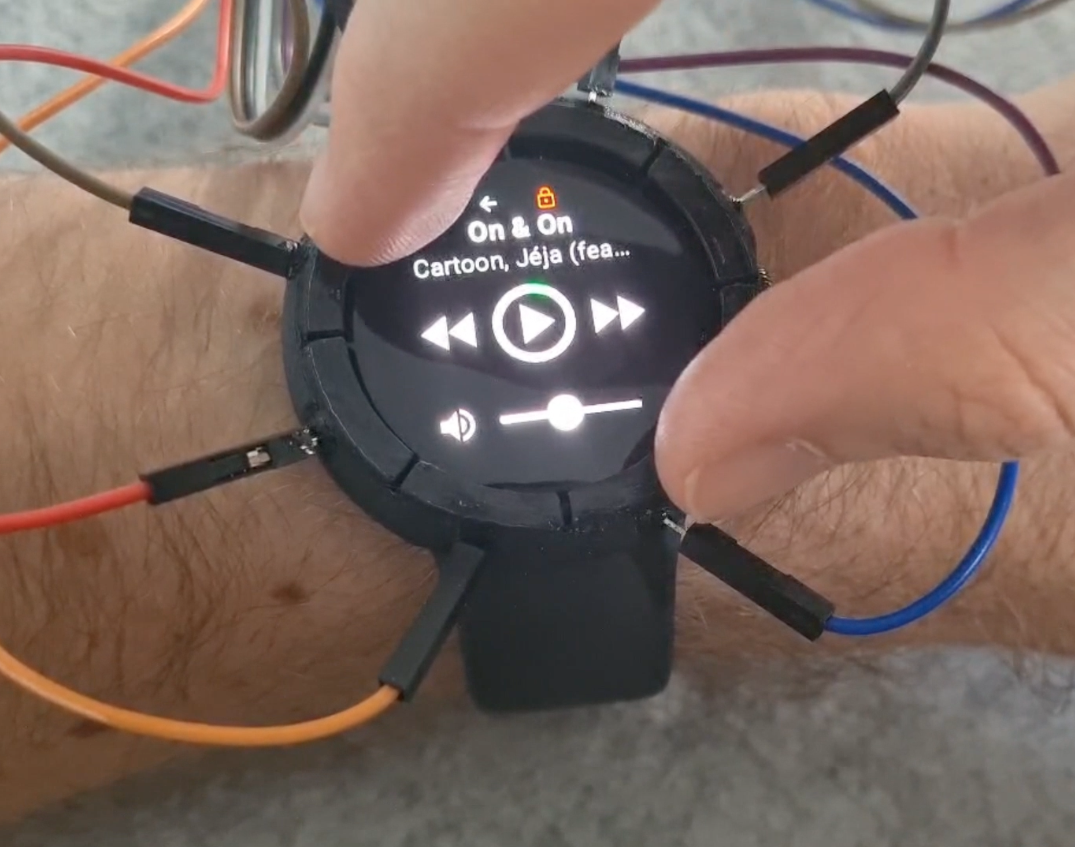 | Reuter, Marvin; Ünal, Ali; Ribeiro, Jan Felipe Kolodziejski; Petersen, David; Böhmer, Matthias: MultiBezel: Adding Multi-Touch to a Smartwatch Bezel to Control Music. In: Adjunct Proceedings of the International Conference on Human Factors in Computing Systems (CHI 2025), ACM, New York, NY, USA, 2025. @inproceedings{reuter2025multibezel,
title = {MultiBezel: Adding Multi-Touch to a Smartwatch Bezel to Control Music},
author = {Marvin Reuter and Ali Ünal and Jan Felipe Kolodziejski Ribeiro and David Petersen and Matthias Böhmer},
url = {https://moxd.io/files/2025/04/Reuter2025MultiBezel.pdf},
year = {2025},
date = {2025-04-28},
urldate = {2025-04-28},
booktitle = {Adjunct Proceedings of the International Conference on Human Factors in Computing Systems (CHI 2025)},
publisher = {ACM},
address = {New York, NY, USA},
keywords = {},
pubstate = {published},
tppubtype = {inproceedings}
}
|
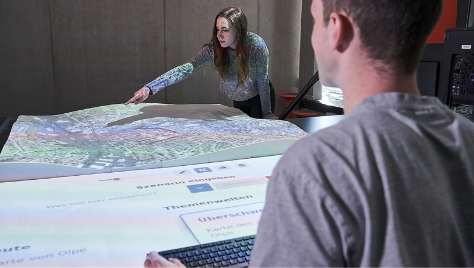 | Reuter, Marvin; Nordhoff, Tim; Schweitzer, Katrin; Engelberth, Sebastian; Böhmer, Matthias: Urban Uchronia: Exploring Alternative Histories and Futures of Cities Using Generative AI and a Projection-Mapped Topography. In: Mensch und Computer 2025 (MuC ’25), 2025. @inproceedings{reuter2025urbanuchrinia,
title = {Urban Uchronia: Exploring Alternative Histories and Futures of Cities Using Generative AI and a Projection-Mapped Topography},
author = {Marvin Reuter and Tim Nordhoff and Katrin Schweitzer and Sebastian Engelberth and Matthias Böhmer},
url = {https://moxd.io/files/2025/07/Reuter2025UrbanUchronia.pdf},
year = {2025},
date = {2025-09-27},
urldate = {2025-09-27},
booktitle = {Mensch und Computer 2025 (MuC ’25)},
keywords = {},
pubstate = {published},
tppubtype = {inproceedings}
}
|
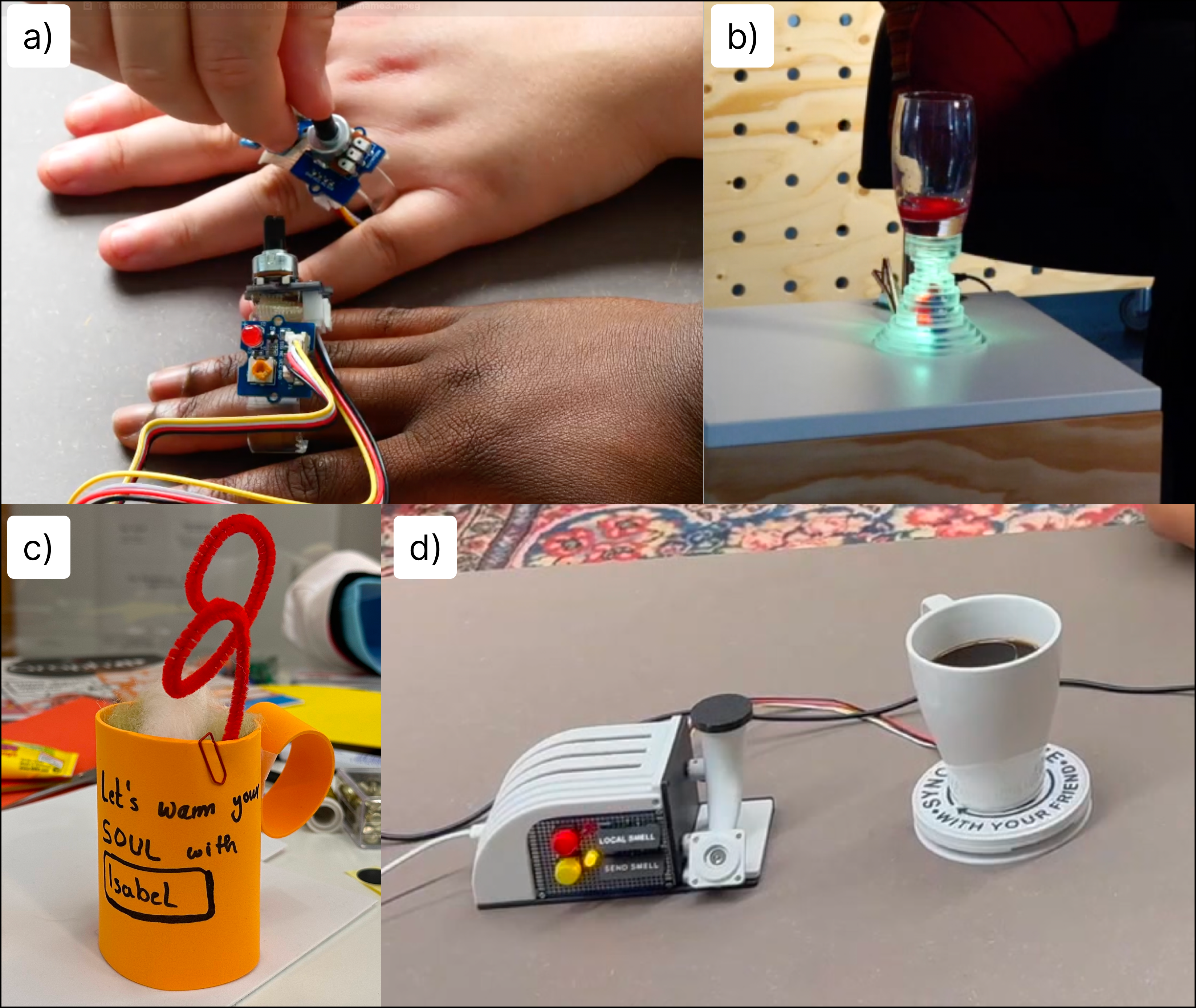 | Huschke, Sabine; Lindt, Irma; Seetohul, Vimal Darius; Lehmann, Carolin; Deimel, Dominik; Böhmer, Matthias: Exploring Common Themes in the Design of Relatedness Technologies for Long-Distance Friendships. In: Human-Computer Interaction - INTERACT 2025, pp. 431-452, Springer Nature Switzerland, 2025, ISBN: 978-3-032-04999-5. @inproceedings{huschke2025themes,
title = {Exploring Common Themes in the Design of Relatedness Technologies for Long-Distance Friendships},
author = {Sabine Huschke and Irma Lindt and Vimal Darius Seetohul and Carolin Lehmann and Dominik Deimel and Matthias Böhmer
},
url = {https://doi.org/10.1007/978-3-032-04999-5_26},
isbn = {978-3-032-04999-5},
year = {2025},
date = {2025-09-08},
urldate = {2025-09-08},
booktitle = {Human-Computer Interaction - INTERACT 2025},
pages = {431-452},
publisher = {Springer Nature Switzerland},
keywords = {},
pubstate = {published},
tppubtype = {inproceedings}
}
|
2024
|
 | Teetz, Max; Petersen, David; Seetohul, Vimal Darius; Böhmer, Matthias: FoldAR: Using the Bended Screen of Foldable Smartphones for Depth Discrimination in Augmented Reality. In: Proceedings of ACM Symposium on Spatial User Interaction (SUI '24), ACM, New York, NY, USA, 2024. @inproceedings{teetz2024foldAR,
title = {FoldAR: Using the Bended Screen of Foldable Smartphones for Depth Discrimination in Augmented Reality},
author = {Max Teetz and David Petersen and Vimal Darius Seetohul and Matthias Böhmer},
url = {https://moxd.io/files/2024/08/Teetz2024FoldAR.pdf
https://doi.org/10.1145/3677386.3688903},
year = {2024},
date = {2024-10-07},
urldate = {2024-10-07},
booktitle = {Proceedings of ACM Symposium on Spatial User Interaction (SUI '24)},
publisher = {ACM, New York, NY, USA},
abstract = {Mobile augmented reality is used in research and many commercial applications. Handheld-based AR has been widely investigated. Interacting in 3D space, however, has shortcomings when interacting along the depth axis on a flat 2D display. This paper presents the concept of FoldAR, which uses the two screen parts of foldable smartphones to display a camera view and a map view. With foldable smartphones users can spatially align the display's two parts with the dimensions of interaction. This allows to manipulate objects on two differently oriented screen parts within all three dimensions at once. We contribute a prototype and discuss possibilities and applications.},
keywords = {},
pubstate = {published},
tppubtype = {inproceedings}
}
Mobile augmented reality is used in research and many commercial applications. Handheld-based AR has been widely investigated. Interacting in 3D space, however, has shortcomings when interacting along the depth axis on a flat 2D display. This paper presents the concept of FoldAR, which uses the two screen parts of foldable smartphones to display a camera view and a map view. With foldable smartphones users can spatially align the display's two parts with the dimensions of interaction. This allows to manipulate objects on two differently oriented screen parts within all three dimensions at once. We contribute a prototype and discuss possibilities and applications. |
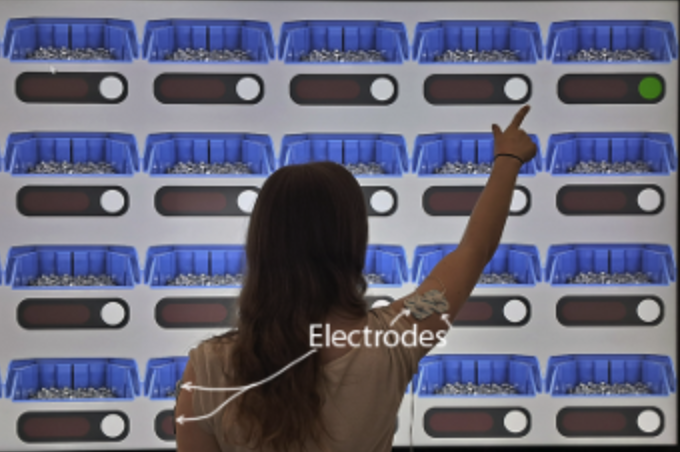 | Seetohul, Vimal Darius; Schweitzer, Katrin; Böhmer, Matthias: ShoulderTapper: Providing Directional Cues through Electrotactile Feedback for Target Acquisition in Pick-by-Light Systems. In: Proceedings of the 23rd International Conference on Mobile and Ubiquitous Multimedia (MUM’24), ACM, New York, NY, USA, 2024. @inproceedings{seetohul2024shouldertapper,
title = {ShoulderTapper: Providing Directional Cues through Electrotactile Feedback for Target Acquisition in Pick-by-Light Systems},
author = {Vimal Darius Seetohul and Katrin Schweitzer and Matthias Böhmer
},
url = {https://moxd.io/files/2024/11/Seetohul2024ShoulderTapper.pdf},
year = {2024},
date = {2024-12-01},
urldate = {2024-12-01},
booktitle = {Proceedings of the 23rd International Conference on Mobile and Ubiquitous Multimedia (MUM’24)},
publisher = {ACM, New York, NY, USA},
keywords = {},
pubstate = {published},
tppubtype = {inproceedings}
}
|
2023
|
 | Eisbach, Simon; Daugs, Fabian; Thielsch, Meinald T.; Böhmer, Matthias; Hertel, Guido: Predicting Rating Distributions of Website Aesthetics with Deep Learning for AI-Based Research. In: ACM Transactions on Computer-Human Interaction, vol. 30, iss. 3, no. 37, pp. 1-28, 2023. @article{tochi2022WebsiteAestheticsDeepLearning,
title = {Predicting Rating Distributions of Website Aesthetics with Deep Learning for AI-Based Research},
author = {Simon Eisbach and Fabian Daugs and Meinald T. Thielsch and Matthias Böhmer and Guido Hertel},
url = {https://dl.acm.org/doi/10.1145/3569889},
year = {2023},
date = {2023-06-10},
urldate = {2023-06-10},
journal = {ACM Transactions on Computer-Human Interaction},
volume = {30},
number = {37},
issue = {3},
pages = {1-28},
abstract = {The aesthetic appeal of a website has strong effects on users’ reactions, appraisals, and even behaviors. However, evaluating website aesthetics through user ratings is resource intensive, and extant models to predict website aesthetics are limited in performance and ability. We contribute a novel and more precise approach to predict website aesthetics that considers rating distributions. Moreover, we use this approach as a baseline model to illustrate how future research might be conducted using predictions instead of participants. Our approach is based on a deep convolutional neural network model and uses innovations in the field of image aesthetic prediction. It was trained with the dataset from Reinecke and Gajos (2014) and was validated using two independent large datasets. The final model reached an unprecedented cross-validated correlation between the ground truth and predicted rating of LCC = 0.752. We then used the model to successfully replicate prior findings and conduct original research as an illustration for AI-based research.},
keywords = {},
pubstate = {published},
tppubtype = {article}
}
The aesthetic appeal of a website has strong effects on users’ reactions, appraisals, and even behaviors. However, evaluating website aesthetics through user ratings is resource intensive, and extant models to predict website aesthetics are limited in performance and ability. We contribute a novel and more precise approach to predict website aesthetics that considers rating distributions. Moreover, we use this approach as a baseline model to illustrate how future research might be conducted using predictions instead of participants. Our approach is based on a deep convolutional neural network model and uses innovations in the field of image aesthetic prediction. It was trained with the dataset from Reinecke and Gajos (2014) and was validated using two independent large datasets. The final model reached an unprecedented cross-validated correlation between the ground truth and predicted rating of LCC = 0.752. We then used the model to successfully replicate prior findings and conduct original research as an illustration for AI-based research. |
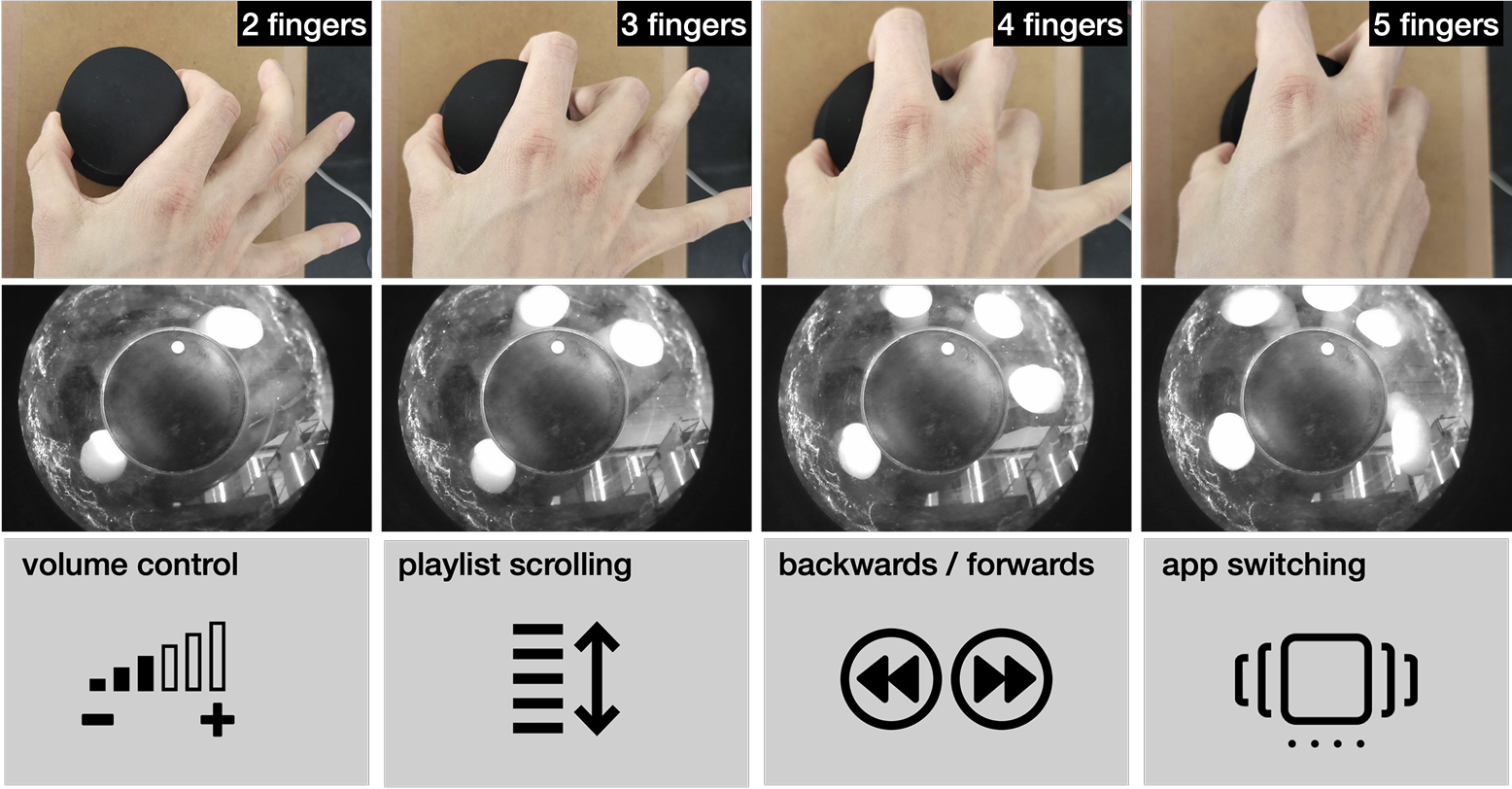 | Petersen, David; Gellert, Edgar; Böhmer, Matthias: Extending the Interaction Space of Rotary Knobs by Multi-touch-based Grasp Recognition. In: Proceedings of the 22nd International Conference on Mobile and Ubiquitous Multimedia, ACM, New York, NY, USA, 2023, (Honorable Mention Award ). @inproceedings{petersen2023multiknob,
title = {Extending the Interaction Space of Rotary Knobs by Multi-touch-based Grasp Recognition},
author = {David Petersen and Edgar Gellert and Matthias Böhmer},
url = {https://dl.acm.org/doi/10.1145/3626705.3627797},
year = {2023},
date = {2023-12-04},
urldate = {2023-12-04},
booktitle = {Proceedings of the 22nd International Conference on Mobile and Ubiquitous Multimedia},
publisher = {ACM, New York, NY, USA},
note = {Honorable Mention Award },
keywords = {},
pubstate = {published},
tppubtype = {inproceedings}
}
|
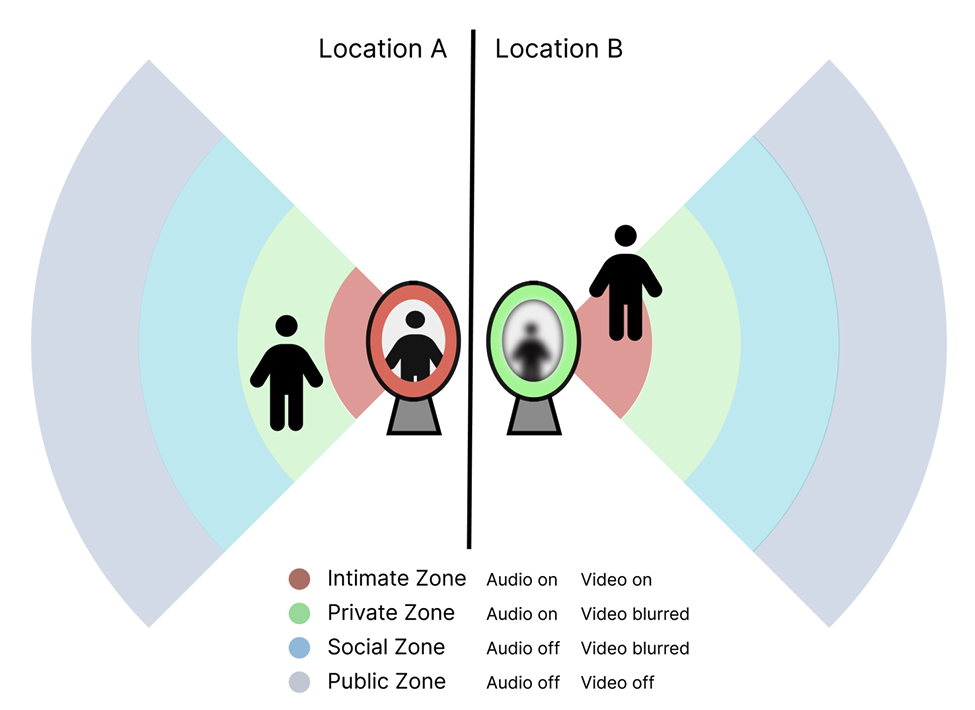 | Huschke, Sabine; Seetohul, Vimal Darius; Lindt, Irma; Böhmer, Matthias: The Friend’s Egg: A Prototype for Spatially Aware, Interpersonal, Audiovisual Remote Communication to Maintain Friendship over Distance. In: Proceedings of the 22nd International Conference on Mobile and Ubiquitous Multimedia, ACM, New York, NY, USA, 2023. @inproceedings{huschke2023friendsegg,
title = {The Friend’s Egg: A Prototype for Spatially Aware, Interpersonal, Audiovisual Remote Communication to Maintain Friendship over Distance},
author = {Sabine Huschke and Vimal Darius Seetohul and Irma Lindt and Matthias Böhmer},
url = {https://dl.acm.org/doi/10.1145/3626705.3631795},
year = {2023},
date = {2023-12-04},
urldate = {2023-12-04},
booktitle = {Proceedings of the 22nd International Conference on Mobile and Ubiquitous Multimedia},
publisher = {ACM, New York, NY, USA},
keywords = {},
pubstate = {published},
tppubtype = {inproceedings}
}
|
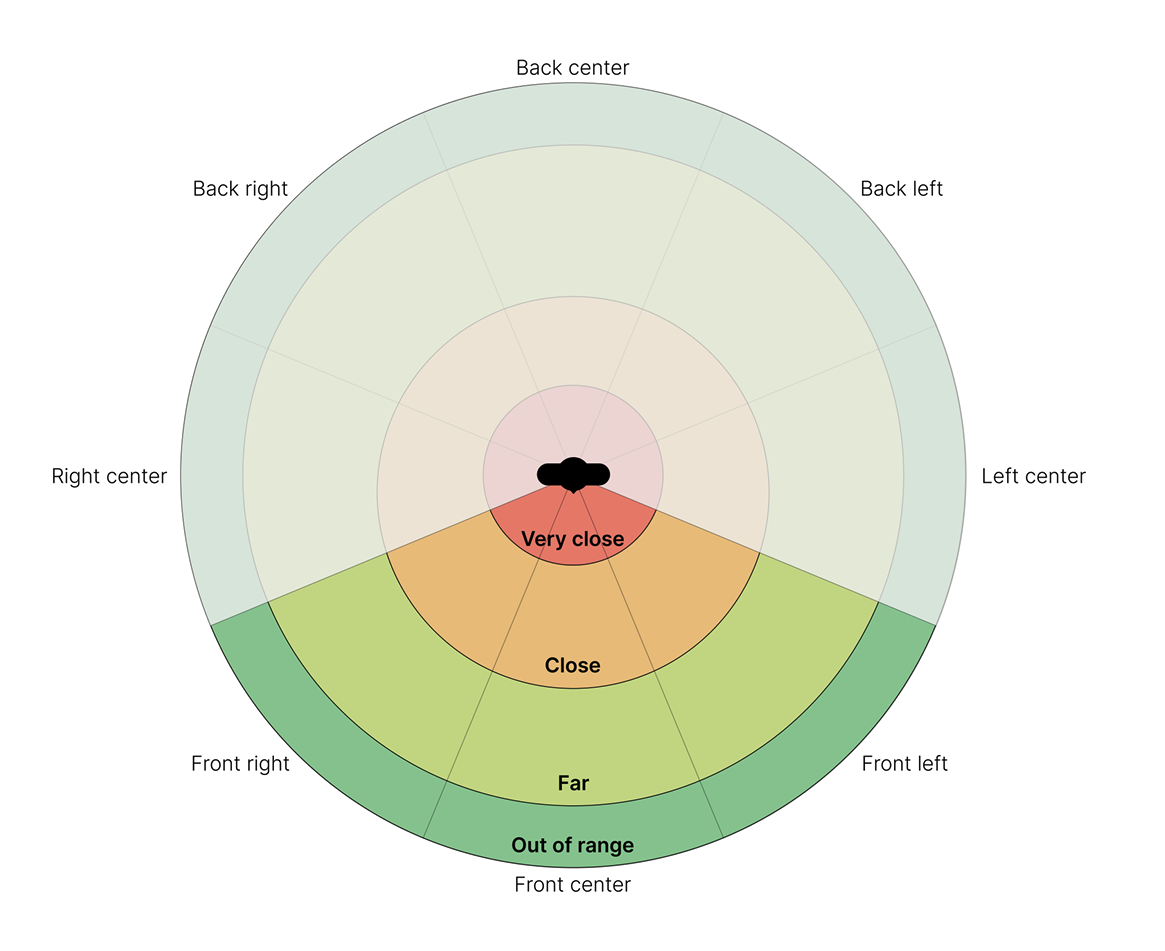 | Seetohul, Vimal Darius; Schweitzer, Katrin; Böhmer, Matthias: Towards Improving Spatial Orientation using Electrical Muscle Stimulation as Tactile and Force Feedback. In: Proceedings of the 22nd International Conference on Mobile and Ubiquitous Multimedia, ACM, New York, NY, USA, 2023. @inproceedings{nokey,
title = {Towards Improving Spatial Orientation using Electrical Muscle Stimulation as Tactile and Force Feedback},
author = {Vimal Darius Seetohul and Katrin Schweitzer and Matthias Böhmer},
url = {https://dl.acm.org/doi/10.1145/3626705.3631792},
year = {2023},
date = {2023-12-04},
urldate = {2023-12-04},
booktitle = {Proceedings of the 22nd International Conference on Mobile and Ubiquitous Multimedia},
publisher = {ACM, New York, NY, USA},
series = {Proceedings of the 22nd International Conference on Mobile and Ubiquitous Multimedia},
keywords = {},
pubstate = {published},
tppubtype = {inproceedings}
}
|
2022
|
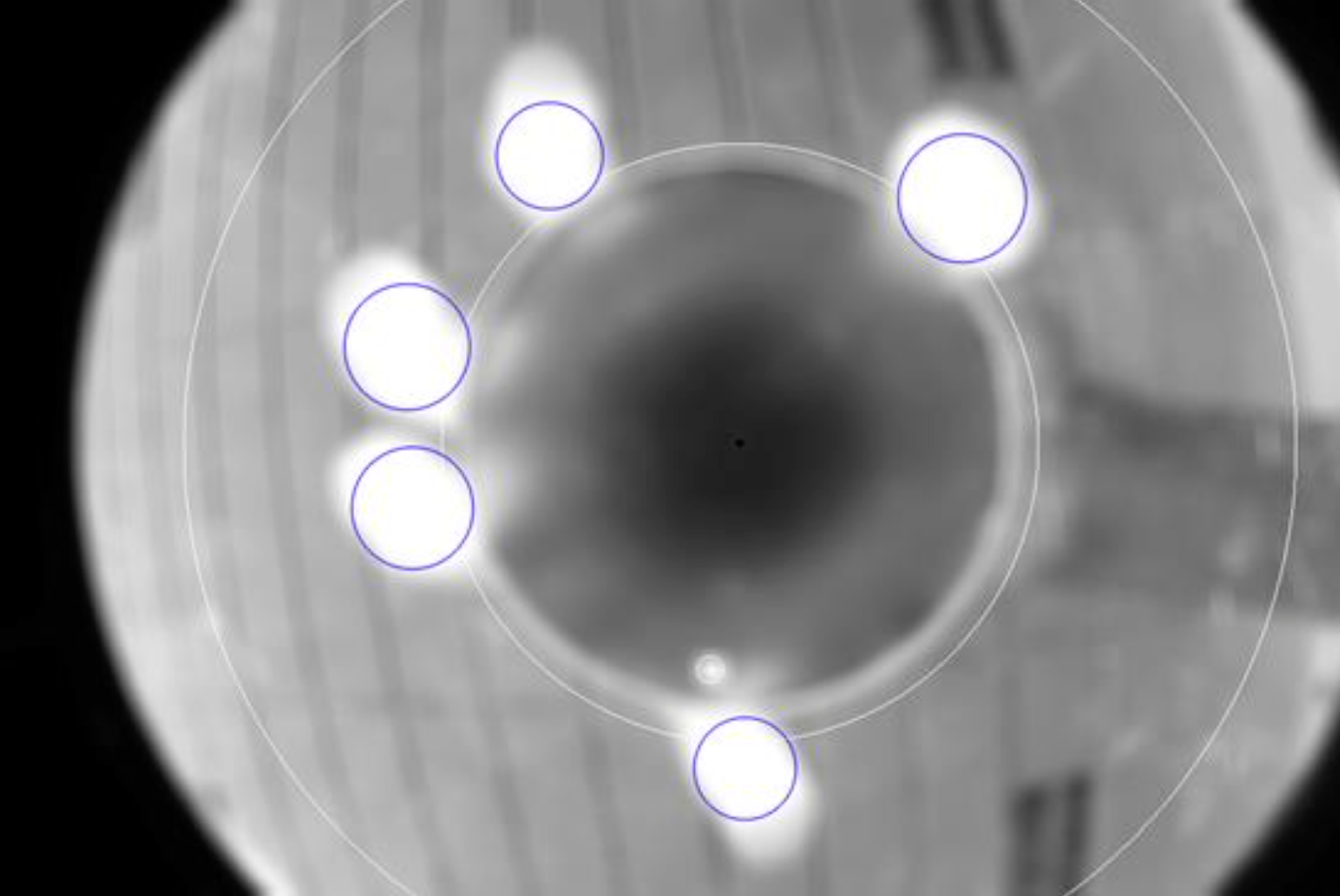 | Gellert, Edgar; Petersen, David; Böhmer, Matthias: MultiKnob — A Knob for Multiplexing Rotation Inputs by Multitouch-based Grasp Recognition. In: Mensch und Computer 2022 (MuC ’22), ACM, New York, NY, USA, 2022. @inproceedings{Gellert2022MultiKnob,
title = {MultiKnob — A Knob for Multiplexing Rotation Inputs by Multitouch-based Grasp Recognition},
author = {Edgar Gellert and David Petersen and Matthias Böhmer},
url = {https://moxd.io/files/2022/09/drea_muc22.pdf
https://dl.acm.org/doi/10.1145/3543758.3547561},
year = {2022},
date = {2022-09-05},
urldate = {2022-09-05},
booktitle = {Mensch und Computer 2022 (MuC ’22)},
publisher = {ACM, New York, NY, USA},
abstract = {Rotary knobs are used on many devices. However, while we enrich the functionalities of smart devices, controlling such functionalities by using the rotation as sole input appears to be rather limited. Therefore, we created a physical rotary controller which enriches the input capabilities of a rotary knob, called MultiKnob. It takes the count of applied fingers as an input parameter for multiplexing rotation. The paper discusses three iterations of our prototyping: Beginning with an attempt to extend an existing rotary controller using conductive paint, to the development of several conductive 3D printed prototypes for use on a smartphone display, to a cylinder sensing multi-touch based on infrared light. We discuss possible applications and limitations of a knob which allows to recognize a user's grasp.},
keywords = {},
pubstate = {published},
tppubtype = {inproceedings}
}
Rotary knobs are used on many devices. However, while we enrich the functionalities of smart devices, controlling such functionalities by using the rotation as sole input appears to be rather limited. Therefore, we created a physical rotary controller which enriches the input capabilities of a rotary knob, called MultiKnob. It takes the count of applied fingers as an input parameter for multiplexing rotation. The paper discusses three iterations of our prototyping: Beginning with an attempt to extend an existing rotary controller using conductive paint, to the development of several conductive 3D printed prototypes for use on a smartphone display, to a cylinder sensing multi-touch based on infrared light. We discuss possible applications and limitations of a knob which allows to recognize a user's grasp. |
2021
|
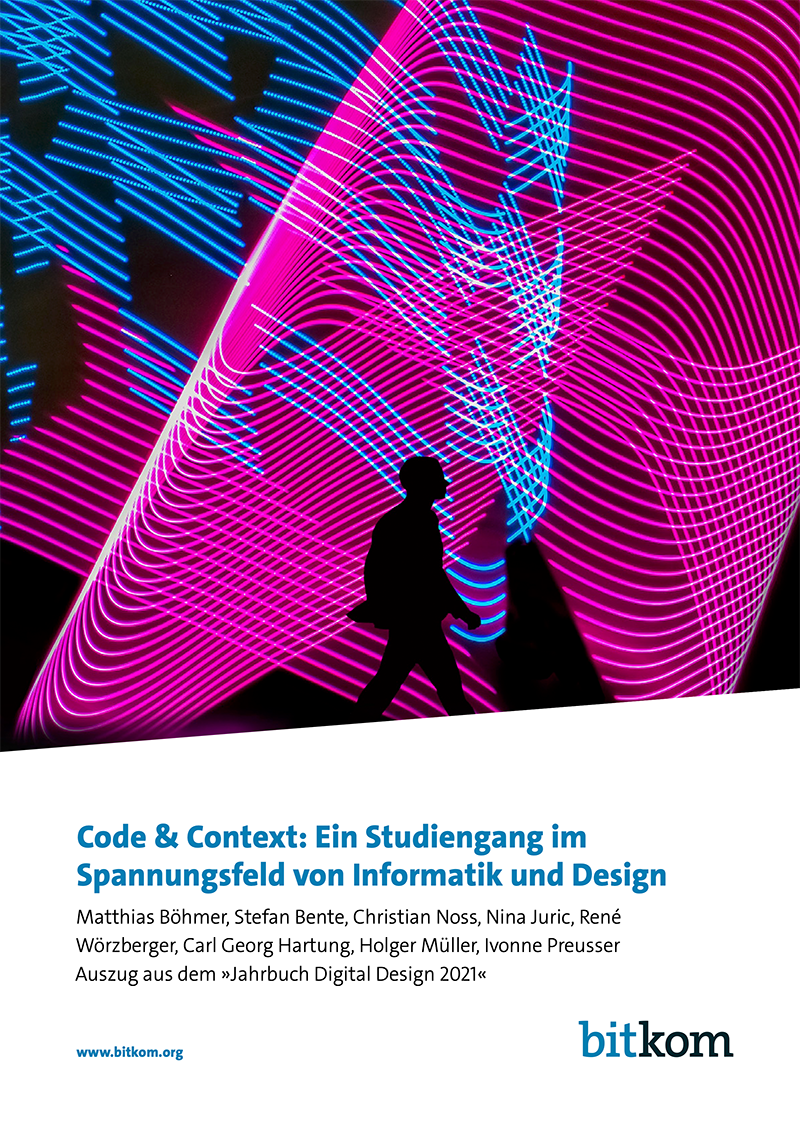 | Böhmer, Matthias; Bente, Stefan; Noss, Christian; Juric, Nina; Wörzberger, René; Hartung, Carl Georg; Müller, Holger; Preusser, Ivonne: Code & Context: Ein Studiengang im Spannungsfeld von Informatik und Design. In: Bitkom, Jahrbuch Digital Design, 2021. @inbook{boehmer2021coco,
title = {Code & Context: Ein Studiengang im Spannungsfeld von Informatik und Design},
author = {Matthias Böhmer and Stefan Bente and Christian Noss and Nina Juric and René Wörzberger and Carl Georg Hartung and Holger Müller and Ivonne Preusser},
url = {https://www.bitkom.org/Themen/Digital-Design-Jahrbuch-2021#boehmer},
year = {2021},
date = {2021-03-19},
publisher = {Bitkom},
edition = {Jahrbuch Digital Design},
abstract = {Die TH Köln realisierte mit dem Studiengang Code & Context ein neues, innovatives Studienangebot im Bereich der exzellenten und praxisnahen Ausbildung von Softwareentwicklerinnen und Softwareentwicklern. Der Studiengang ist ein interdisziplinärer Informatik-Bachelorstudiengang mit Werkstattcharakter, der die Themen Coding, Design und Entrepreneurship vereint. Im Studiengang werden fachlich versierte, kreative Persönlichkeiten mit kritischer Haltung, starkem Gestaltungswillen, technischem Verständnis und sozialem Verantwortungsbewusstsein ausgebildet, die als Gestalterinnen und Gestalter von Digitalisierungsthemen und digitaler Transformation tätig sein werden. Dabei werden digitale Systeme ganzheitlich und über Fachgrenzen hinweg konzipiert und realisiert. Dieser Artikel beschreibt die Entwicklung des neuen Studiengangs, gibt Einblicke in den aktuellen Status Quo und schildert Ansätze zur Weiterentwicklung.},
keywords = {},
pubstate = {published},
tppubtype = {inbook}
}
Die TH Köln realisierte mit dem Studiengang Code & Context ein neues, innovatives Studienangebot im Bereich der exzellenten und praxisnahen Ausbildung von Softwareentwicklerinnen und Softwareentwicklern. Der Studiengang ist ein interdisziplinärer Informatik-Bachelorstudiengang mit Werkstattcharakter, der die Themen Coding, Design und Entrepreneurship vereint. Im Studiengang werden fachlich versierte, kreative Persönlichkeiten mit kritischer Haltung, starkem Gestaltungswillen, technischem Verständnis und sozialem Verantwortungsbewusstsein ausgebildet, die als Gestalterinnen und Gestalter von Digitalisierungsthemen und digitaler Transformation tätig sein werden. Dabei werden digitale Systeme ganzheitlich und über Fachgrenzen hinweg konzipiert und realisiert. Dieser Artikel beschreibt die Entwicklung des neuen Studiengangs, gibt Einblicke in den aktuellen Status Quo und schildert Ansätze zur Weiterentwicklung. |
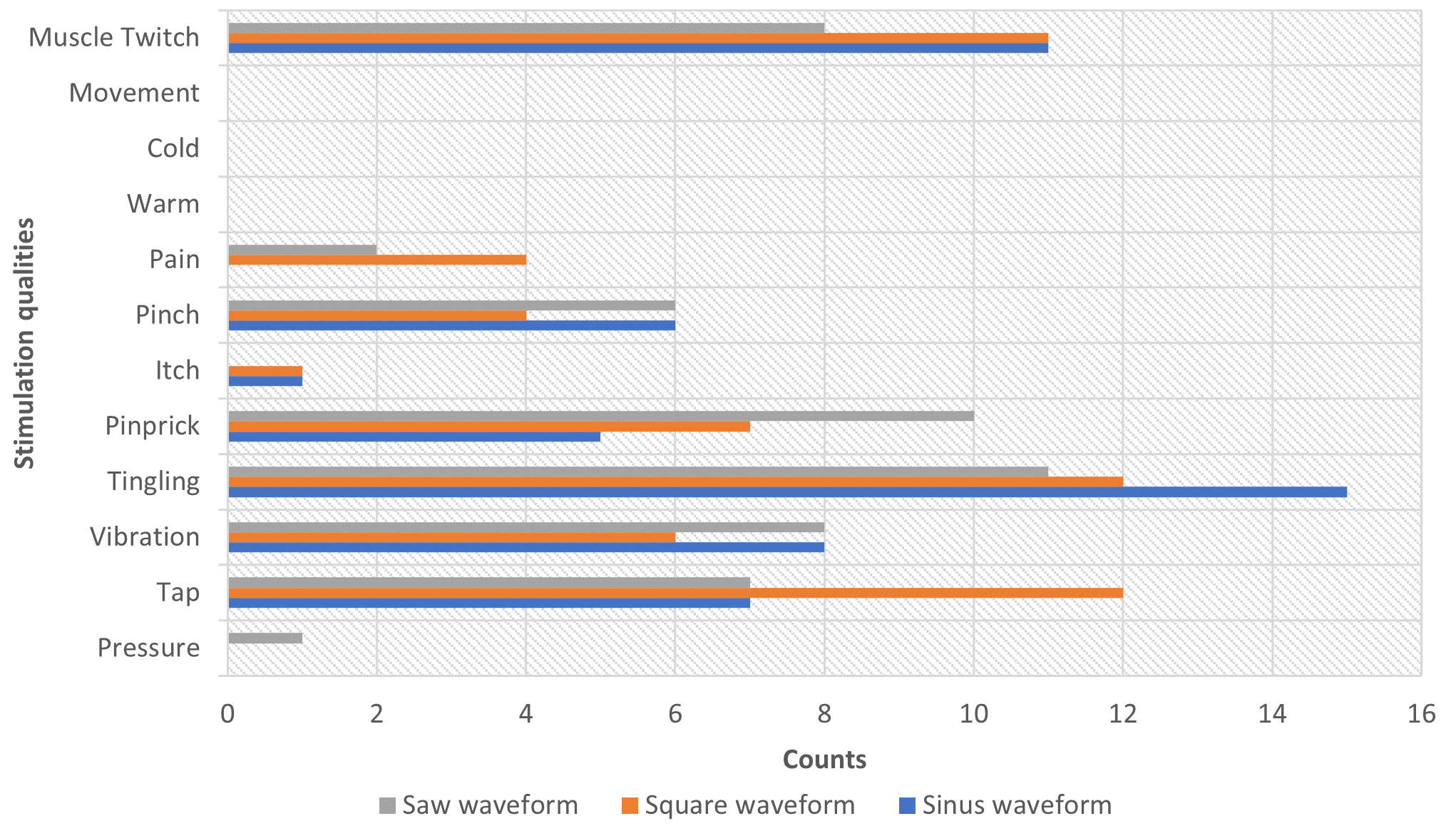 | Seetohul, Vimal Darius; Böhmer, Matthias: Towards Enhancing Spatial Awareness through Electrical Muscle Stimulation. In: EICS ’21: The 13th ACM SIGCHI Symposium on Engineering Interactive Computer Systems, pp. 17-21, Association for Computing Machinery, New York, NY, USA, 2021, ISBN: 9781450384490. @inproceedings{10.1145/3459926.3464750,
title = {Towards Enhancing Spatial Awareness through Electrical Muscle Stimulation},
author = {Vimal Darius Seetohul and Matthias Böhmer},
url = {https://moxd.io/files/2021/06/Towards-Enhancing-Spatial-Awareness-through-Electrical-Muscle-Stimulation.pdf},
doi = {10.1145/3459926.3464750},
isbn = {9781450384490},
year = {2021},
date = {2021-06-08},
urldate = {2021-06-08},
booktitle = {EICS ’21: The 13th ACM SIGCHI Symposium on Engineering Interactive Computer Systems},
pages = {17-21},
publisher = {Association for Computing Machinery},
address = {New York, NY, USA},
series = {EICS '21},
abstract = {With advances of new technologies there is a growing interest in augmenting human senses with sensory information. This paper aims at using electrical muscle stimulation (EMS) to support sensing the proximity of objects. We propose a concept relating distance to properties of electrical muscle stimulation. Our study provides first evidence that our approach can be used to convey information on the proximity of objects to users of the EMS system. We report on the correlations between a simulated proximity and the proximity felt based on EMS. Based on this we propose fields of applications which can benefit from such a system. Our approach can be used where people need to be notified with regard to spatial information, e.g., dangerous objects approaching from behind.},
keywords = {},
pubstate = {published},
tppubtype = {inproceedings}
}
With advances of new technologies there is a growing interest in augmenting human senses with sensory information. This paper aims at using electrical muscle stimulation (EMS) to support sensing the proximity of objects. We propose a concept relating distance to properties of electrical muscle stimulation. Our study provides first evidence that our approach can be used to convey information on the proximity of objects to users of the EMS system. We report on the correlations between a simulated proximity and the proximity felt based on EMS. Based on this we propose fields of applications which can benefit from such a system. Our approach can be used where people need to be notified with regard to spatial information, e.g., dangerous objects approaching from behind. |
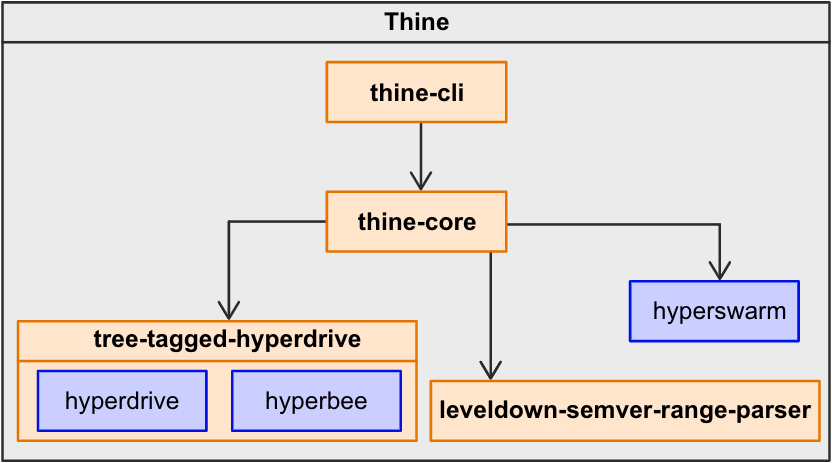 | Blähser, Jannik; Göller, Tim; Böhmer, Matthias: Thine - Approach for a fault tolerant distributed packet manager based on hypercore protocol. The 6th IEEE International Workshop on Dew Computing, 2021, ISBN: 978-1-6654-2463-9. @conference{blaehser2021thine,
title = {Thine - Approach for a fault tolerant distributed packet manager based on hypercore protocol},
author = {Jannik Blähser and Tim Göller and Matthias Böhmer},
url = {https://ieeexplore.ieee.org/abstract/document/9529611},
doi = {10.1109/COMPSAC51774.2021.00266},
isbn = {978-1-6654-2463-9},
year = {2021},
date = {2021-09-09},
booktitle = {The 6th IEEE International Workshop on Dew Computing},
keywords = {},
pubstate = {published},
tppubtype = {conference}
}
|
2020
|
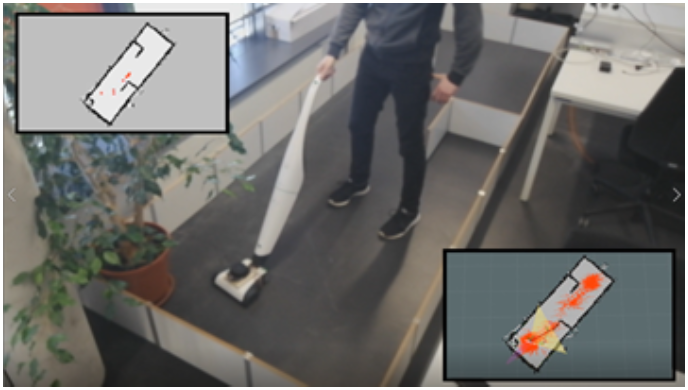 | Blähser, Jannik; Kremer, Frank; Jansen, Patrick; Abel, Robin; Böhmer, Matthias: Improving Mixed-initiative Collaboration between Humans and Robots when Vacuuming the Floor by Tracking Manual Cleaning. In: NordiCHI 2020 Workshop on The UX of Interactive Machine Learning, 2020. @inproceedings{blaehser2020,
title = {Improving Mixed-initiative Collaboration between Humans and Robots when Vacuuming the Floor by Tracking Manual Cleaning},
author = {Jannik Blähser and Frank Kremer and Patrick Jansen and Robin Abel and Matthias Böhmer},
url = {http://moxd.io/files/2020/11/NordiCHI2020-blaehser.pdf},
year = {2020},
date = {2020-09-21},
booktitle = {NordiCHI 2020 Workshop on The UX of Interactive Machine Learning},
abstract = {Autonomous vacuum cleaning robots often miss small spots of dirty areas which in turn have to be cleaned manually. This leads to shortcomings of autonomous cleaning assistants. However, a robot’s cleaning process can be improved by using information about which areas have been vacuumed manually. By learning which spots are repeatedly gone over by humans and can lead to a mixed-initiative interaction between the human and robots. We developed a prototype of a handheld vacuum cleaner which can track the areas which it is used it for cleaning by the very human. This work-in-progress paper contributes our mixed-initiative approach of vacuuming and a technical prototype. We also discuss further steps and evaluating the prototype.},
keywords = {},
pubstate = {published},
tppubtype = {inproceedings}
}
Autonomous vacuum cleaning robots often miss small spots of dirty areas which in turn have to be cleaned manually. This leads to shortcomings of autonomous cleaning assistants. However, a robot’s cleaning process can be improved by using information about which areas have been vacuumed manually. By learning which spots are repeatedly gone over by humans and can lead to a mixed-initiative interaction between the human and robots. We developed a prototype of a handheld vacuum cleaner which can track the areas which it is used it for cleaning by the very human. This work-in-progress paper contributes our mixed-initiative approach of vacuuming and a technical prototype. We also discuss further steps and evaluating the prototype. |
2019
|
 | Gellert, Edgar; Böhmer, Matthias: Collaborative Homes: Exchange of learned interaction patterns to support networked living. In: Poster Proceedings of European Conference on Ambient Intelligence 2019, 2019. @inproceedings{gellert2019,
title = {Collaborative Homes: Exchange of learned interaction patterns to support networked living},
author = {Edgar Gellert and Matthias Böhmer},
url = {http://moxd.io/files/2019/11/AmI2019-CollaborativeHomes.pdf},
year = {2019},
date = {2019-11-27},
booktitle = {Poster Proceedings of European Conference on Ambient Intelligence 2019},
issuetitle = {Poster Proceedings of European Conference on Ambient Intelligence 2019},
abstract = {The adoption of smart homes is steadily increasing and users expect their homes to act in intelligent ways. One core question is how to learn from user behavior to gain smartness that can be adopted by the system. This paper has a twofold contribution: first, we propose a new approach for letting smart homes learn collaboratively. Second, we present a prototype implementation and discuss challenges learned from this version. This approach should serve as an initiator for the development of intelligent smart home systems outside isolated solutions and on the basis of human needs.},
keywords = {},
pubstate = {published},
tppubtype = {inproceedings}
}
The adoption of smart homes is steadily increasing and users expect their homes to act in intelligent ways. One core question is how to learn from user behavior to gain smartness that can be adopted by the system. This paper has a twofold contribution: first, we propose a new approach for letting smart homes learn collaboratively. Second, we present a prototype implementation and discuss challenges learned from this version. This approach should serve as an initiator for the development of intelligent smart home systems outside isolated solutions and on the basis of human needs. |
 | Böhmer, Matthias; Scherfer, Konrad; Zabel, Christian: Entwicklung einer digitalen Medien-App Ein interdisziplinäres Lehrkonzept dreier Fakultäten. In: Neues Handbuch Hochschullehre, vol. 92, 2019. @incollection{boehmer2019mediaapp,
title = {Entwicklung einer digitalen Medien-App Ein interdisziplinäres Lehrkonzept dreier Fakultäten},
author = {Matthias Böhmer and Konrad Scherfer and Christian Zabel},
year = {2019},
date = {2019-10-18},
booktitle = {Neues Handbuch Hochschullehre},
volume = {92},
keywords = {},
pubstate = {published},
tppubtype = {incollection}
}
|
2018
|
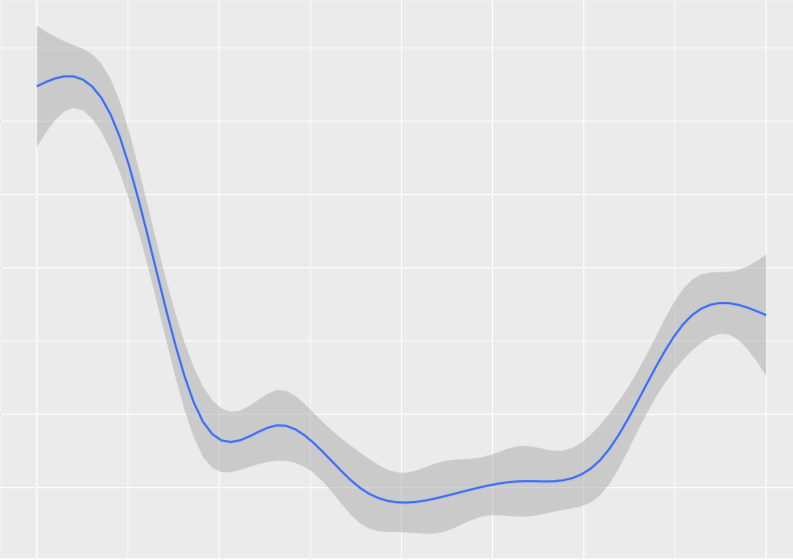 | Petersen, David; Böhmer, Matthias: Understanding Mobile Information Supply: Studying the Amount of Textual Information Smartphones Provide. In: Proceedings of NordiCHI 2018, ACM, 2018. @inproceedings{petersen2018MobileInformationSupply,
title = {Understanding Mobile Information Supply: Studying the Amount of Textual Information Smartphones Provide},
author = {David Petersen and Matthias Böhmer},
url = {http://moxd.io/files/2018/08/Nordichi2018-MobileInformationSupply.pdf},
year = {2018},
date = {2018-00-00},
booktitle = {Proceedings of NordiCHI 2018},
publisher = {ACM},
keywords = {},
pubstate = {published},
tppubtype = {inproceedings}
}
|
| Edge, Robert; Mussack, Dominic; Böhmer, Matthias; Schrater, Paul: Predicting Contextual Influences on App Usage from a Rational Model of Time Allocation. In: 2018 IEEE International Conference on Pervasive Computing and Communications Workshops (PerCom Workshops)
, IEEE, 2018. @inproceedings{edge2018predicting,
title = {Predicting Contextual Influences on App Usage from a Rational Model of Time Allocation},
author = {Robert Edge and Dominic Mussack and Matthias Böhmer and Paul Schrater},
year = {2018},
date = {2018-00-00},
booktitle = {2018 IEEE International Conference on Pervasive Computing and Communications Workshops (PerCom Workshops)
},
journal = {IEEE International Conference on Pervasive Computing and Communications Workshops (PerCom Workshops). IEEE, 2018.},
publisher = {IEEE},
keywords = {},
pubstate = {published},
tppubtype = {inproceedings}
}
|
2017
|
| Reschke, Daniela; Böhmer, Matthias; Sorg, Manuel: Tactifloor: design and evaluation of vibration signals for doorway reminder systems. In: Proceedings of the 16th International Conference on Mobile and Ubiquitous Multimedia, pp. 449–455, ACM 2017. @inproceedings{reschke2017tactifloor,
title = {Tactifloor: design and evaluation of vibration signals for doorway reminder systems},
author = {Daniela Reschke and Matthias Böhmer and Manuel Sorg},
year = {2017},
date = {2017-01-01},
booktitle = {Proceedings of the 16th International Conference on Mobile and Ubiquitous Multimedia},
pages = {449--455},
organization = {ACM},
keywords = {},
pubstate = {published},
tppubtype = {inproceedings}
}
|
2014
|
| Böhmer, Matthias; Lander, Christian; Gehring, Sven; Brumby, Duncan P; Krüger, Antonio: Interrupted by a phone call: exploring designs for lowering the impact of call notifications for smartphone users. In: Proceedings of the SIGCHI Conference on Human Factors in Computing Systems, pp. 3045–3054, ACM 2014. @inproceedings{bohmer2014interrupted,
title = {Interrupted by a phone call: exploring designs for lowering the impact of call notifications for smartphone users},
author = {Matthias Böhmer and Christian Lander and Sven Gehring and Duncan P Brumby and Antonio Krüger},
year = {2014},
date = {2014-01-01},
booktitle = {Proceedings of the SIGCHI Conference on Human Factors in Computing Systems},
pages = {3045--3054},
organization = {ACM},
keywords = {},
pubstate = {published},
tppubtype = {inproceedings}
}
|
| Böhmer, Matthias; Krüger, Antonio: A Case Study of Research through the App Store: Leveraging the System UI as a Playing Field for Improving the Design of Smartphone Launchers. In: International Journal of Mobile Human Computer Interaction (IJMHCI), vol. 6, no. 2, pp. 32–45, 2014. @article{bohmer2014case,
title = {A Case Study of Research through the App Store: Leveraging the System UI as a Playing Field for Improving the Design of Smartphone Launchers},
author = {Matthias Böhmer and Antonio Krüger},
year = {2014},
date = {2014-01-01},
journal = {International Journal of Mobile Human Computer Interaction (IJMHCI)},
volume = {6},
number = {2},
pages = {32--45},
publisher = {IGI Global},
keywords = {},
pubstate = {published},
tppubtype = {article}
}
|
2013
|
| Böhmer, Matthias; Krüger, Antonio: A Study on Icon Arrangement by Smartphone Users. In: CHI '13 Proceedings of the SIGCHI Conference on Human Factors in Computing Systems, 2013. @inproceedings{bohmer2013study,
title = {A Study on Icon Arrangement by Smartphone Users},
author = {Matthias Böhmer and Antonio Krüger},
year = {2013},
date = {2013-01-01},
booktitle = {CHI '13 Proceedings of the SIGCHI Conference on Human Factors in Computing Systems},
keywords = {},
pubstate = {published},
tppubtype = {inproceedings}
}
|
| Böhmer, Matthias; Ganev, Lyubomir; Krüger, Antonio: AppFunnel: A Framework for Usage-centric Evaluation of Recommender Systems that Suggest Mobile Applications. In: Proceedings of the 2013 ACM international conference on Intelligent User Interfaces, 2013. @inproceedings{bohmer2013appfunnel,
title = {AppFunnel: A Framework for Usage-centric Evaluation of Recommender Systems that Suggest Mobile Applications},
author = {Matthias Böhmer and Lyubomir Ganev and Antonio Krüger},
year = {2013},
date = {2013-01-01},
booktitle = {Proceedings of the 2013 ACM international conference on Intelligent User Interfaces},
keywords = {},
pubstate = {published},
tppubtype = {inproceedings}
}
|
| Böhmer, Matthias; Saponas, Scott T; Teevan, Jaime: Smartphone Use Does Not Have to Be Rude: Making Phones a Collaborative Presence in Meetings. In: MobileHCI 2013, 2013. @inproceedings{bohmer2013smartphone,
title = {Smartphone Use Does Not Have to Be Rude: Making Phones a Collaborative Presence in Meetings},
author = {Matthias Böhmer and Scott T Saponas and Jaime Teevan},
year = {2013},
date = {2013-01-01},
booktitle = {MobileHCI 2013},
keywords = {},
pubstate = {published},
tppubtype = {inproceedings}
}
|
| Parate, Abhinav; Böhmer, Matthias; Chu, David; Ganesan, Deepak; Marlin, Benjamin: Practical Prediction and Prefetch for Faster Access to Applications on Mobile phones. In: Proceedings of the 2013 ACM international joint conference on Pervasive and ubiquitous computing, pp. 275–284, ACM 2013. @inproceedings{parate2013practical,
title = {Practical Prediction and Prefetch for Faster Access to Applications on Mobile phones},
author = {Abhinav Parate and Matthias Böhmer and David Chu and Deepak Ganesan and Benjamin Marlin},
year = {2013},
date = {2013-01-01},
booktitle = {Proceedings of the 2013 ACM international joint conference on Pervasive and ubiquitous computing},
pages = {275--284},
organization = {ACM},
keywords = {},
pubstate = {published},
tppubtype = {inproceedings}
}
|
| Böhmer, Matthias; Hempel, Jonas; Gehring, Sven; Krüger, Antonio: Revisiting Phone Call UIs for Multipurpose Mobile Phones. In: 2013. @article{bohmer2013revisiting,
title = {Revisiting Phone Call UIs for Multipurpose Mobile Phones},
author = {Matthias Böhmer and Jonas Hempel and Sven Gehring and Antonio Krüger},
year = {2013},
date = {2013-01-01},
keywords = {},
pubstate = {published},
tppubtype = {article}
}
|
| Löchtefeld, Markus; Böhmer, Matthias; Daiber, Florian; Gehring, Sven: Augmented reality-based advertising strategies for paper leaflets. In: Proceedings of the 2013 ACM conference on Pervasive and ubiquitous computing adjunct publication, pp. 1015–1022, ACM 2013. @inproceedings{lochtefeld2013augmented,
title = {Augmented reality-based advertising strategies for paper leaflets},
author = {Markus Löchtefeld and Matthias Böhmer and Florian Daiber and Sven Gehring},
year = {2013},
date = {2013-01-01},
booktitle = {Proceedings of the 2013 ACM conference on Pervasive and ubiquitous computing adjunct publication},
pages = {1015--1022},
organization = {ACM},
keywords = {},
pubstate = {published},
tppubtype = {inproceedings}
}
|
| Löchtefeld, Markus; Böhmer, Matthias; Ganev, Lyubomir: AppDetox: helping users with mobile app addiction. In: Proceedings of the 12th International Conference on Mobile and Ubiquitous Multimedia, pp. 43, ACM 2013. @inproceedings{lochtefeld2013appdetox,
title = {AppDetox: helping users with mobile app addiction},
author = {Markus Löchtefeld and Matthias Böhmer and Lyubomir Ganev},
year = {2013},
date = {2013-01-01},
booktitle = {Proceedings of the 12th International Conference on Mobile and Ubiquitous Multimedia},
pages = {43},
organization = {ACM},
keywords = {},
pubstate = {published},
tppubtype = {inproceedings}
}
|
2011
|
 | Böhmer, Matthias; Hecht, Brent; Schöning, Johannes; Krüger, Antonio; Bauer, Gernot: Falling asleep with Angry Birds, Facebook and Kindle: a large scale study on mobile application usage. In: Proceedings of the 13th international conference on Human-computer interaction with mobile devices and services, pp. 47–56, ACM 2011. @inproceedings{bohmer2011falling,
title = {Falling asleep with Angry Birds, Facebook and Kindle: a large scale study on mobile application usage},
author = {Matthias Böhmer and Brent Hecht and Johannes Schöning and Antonio Krüger and Gernot Bauer},
url = {https://moxd.io/files/2018/09/Boehmer-MobileHCI11-AppSensor.pdf},
year = {2011},
date = {2011-01-01},
booktitle = {Proceedings of the 13th international conference on Human-computer interaction with mobile devices and services},
pages = {47--56},
organization = {ACM},
keywords = {},
pubstate = {published},
tppubtype = {inproceedings}
}
|



















